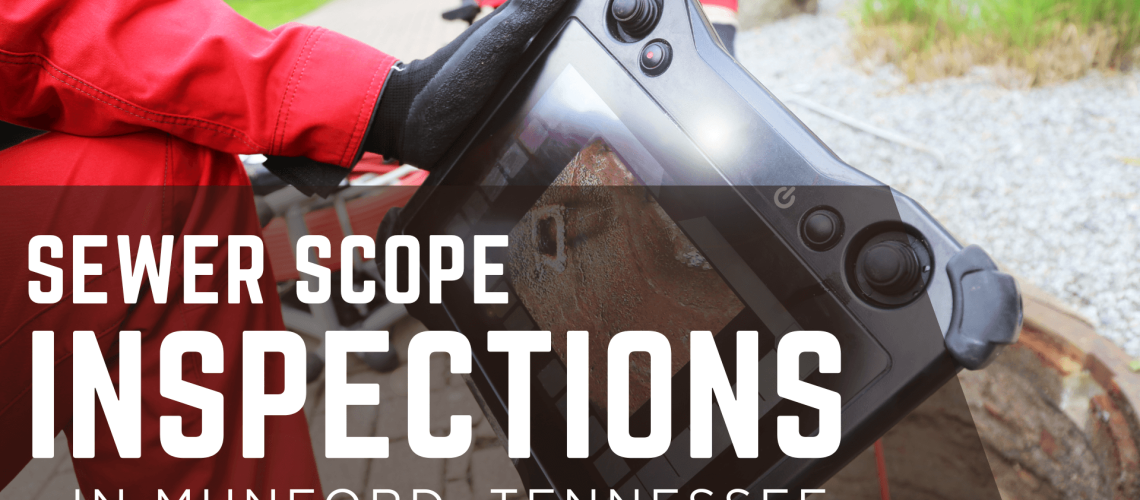When you’re buying a home in Munford, Tennessee, there’s one part of the property that most buyers never see — and that’s the sewer line. Hidden underground, this pipe carries all household wastewater out to the city main or septic system. It’s easy to assume everything is fine, but when a sewer line fails, repairs can range from hundreds to thousands of dollars — often right after move-in.
That’s why more and more homebuyers across Tipton County are adding a sewer scope inspection to their standard home inspection. It’s a simple, affordable test that can uncover serious problems before they become your responsibility.
What Is a Sewer Scope Inspection?
A sewer scope inspection involves running a small, high-resolution camera through the home’s main drain line — usually from a cleanout near the house or yard. The camera records video as it travels toward the city main or septic connection, showing the interior condition of the pipe.
In my inspections around Munford, Atoka, and Brighton, I use a specialized waterproof camera with lighting and distance tracking. This allows me to identify exactly where issues occur, how severe they are, and whether repairs are needed immediately or can be planned for later.
The process typically takes less than an hour and can save homeowners from major surprise expenses.
Why It Matters — Especially in Older Homes
Many homes in and around Munford were built in the 1970s through 1990s, and those decades saw a variety of sewer line materials used — including clay, cast iron, and early PVC. Each comes with its own potential problems:
- Clay pipes are prone to cracking and root intrusion at the joints.
- Cast iron pipes rust and scale from the inside out, reducing flow and sometimes collapsing.
- Older PVC lines can sag or separate at joints due to poor installation or soil movement.
Even newer homes aren’t immune. Construction debris, improper slope, or soil settling after backfill can all create blockages or “bellies” in the line that lead to standing water and slow drains.
A sewer scope is the only reliable way to see what’s really happening underground.
Common Problems Found During Sewer Scope Inspections
When I perform sewer scope inspections in Munford and nearby communities, these are the issues I most often discover:
1. Root Intrusion
Tree roots naturally seek out moisture — and the joints of aging sewer lines are perfect entry points. Once inside, they grow quickly, trapping debris and causing backups.
2. Pipe Bellies and Low Spots
A “belly” occurs when a section of pipe sags, often from soil settlement or erosion. Water and waste collect in the low spot, leading to repeated clogs and corrosion.
3. Separated or Offset Joints
As soil shifts or foundations settle, pipes can separate slightly at the connections. Even a small gap allows water and soil to infiltrate, eventually leading to collapse.
4. Cracks, Corrosion, and Scaling
Metal and clay pipes naturally deteriorate over time. Corrosion flakes or sediment can narrow the pipe’s diameter and cause blockages.
5. Construction Debris or Foreign Objects
It’s not unusual to find chunks of concrete, rocks, or even old tools left behind during original construction. These obstructions can snag paper and waste, starting a cycle of slow drains and backups.
6. Missing Cleanouts or Improper Access
Some older homes were never fitted with proper cleanouts, making maintenance and repair more complicated. Identifying this during inspection helps homeowners plan access improvements if needed.
What Happens If Problems Are Found?
If your sewer scope reveals damage or obstructions, the report and video footage will show exactly where and what the issue is. That documentation can be invaluable during a real estate transaction.
For buyers, it provides leverage to negotiate repairs or credits before closing. For sellers, it offers proof of condition — helping prevent disputes later.
In some cases, minor issues can be resolved with simple cleaning or root removal. More serious damage may require partial replacement or relining of the affected section. Either way, having the inspection done before purchase helps you make an informed decision.
Why It’s Worth the Cost
Compared to the price of excavation or emergency repairs, a sewer scope inspection is an incredible value. In most cases, it costs less than a routine plumbing service call and provides long-term insight into one of the most important (and expensive) systems in your home.
It’s especially recommended for:
- Homes built before 2000
- Properties with large trees near sewer lines
- Homes that have experienced repeated drain clogs or backups
- Any property with unknown pipe materials or prior plumbing work
A Proactive Step for Peace of Mind
Homebuyers often focus on visible systems — the roof, HVAC, or electrical — while the most critical one runs silently underground. A sewer scope inspection fills that gap.
At Upchurch Inspection, I perform detailed sewer scope evaluations using professional-grade camera equipment. You’ll receive clear video documentation, explanations of any findings, and recommendations for repair or maintenance.
In most cases, these inspections catch issues early — when they’re easy and affordable to fix — rather than after a costly backup occurs.
📞 Schedule Your Munford Sewer Scope or Home Inspection Today
Serving Munford, Atoka, Brighton, and communities across West Tennessee, Upchurch Inspection provides certified home inspections, sewer scope evaluations, and specialized testing for mold, radon, and water quality.
📞 Call (901) 350-8885 or visit UpchurchInspection.com to schedule your inspection today.


